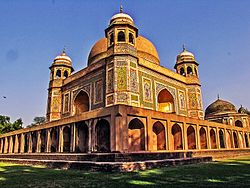Tourism in Punjab, India
This article possibly contains original research. (July 2019) |

The state of Punjab is renowned for its cuisine, culture and history. Punjab has a vast public transportation and communication network. Some of the main cities in Punjab are Amritsar, Ludhiana, Jalandhar, Patiala, Mohali, Bathinda, Firozpur and Pathankot. Patiala is known for its historical forts. Punjab also has a rich Sikh religious history.
Punjab receives many religious tourists, as the state is home to some of the holiest places in Sikhism, including the Harmandir Sahib[1] and three of the five Panj Takht.
Attari border[edit]

Wagah (Punjabi (Gurmukhi): ਵਾਹਗਾ, Hindi: वाघा, Urdu: واہگہ) is a village situated near a road border crossing, goods transit terminal and a railway station between Pakistan and India,[1] and lies on the Grand Trunk Road between the cities of Amritsar, Punjab, India, and Lahore, Punjab, Pakistan.
The border is located 24 kilometres (15 mi) from Lahore and 32 kilometres (20 mi) from Amritsar. It is also 3 kilometres (1.9 mi) from the bordering village of Attari.
Wagah, named Wahga in Pakistan, is a village near which the accepted Radcliffe Line, the boundary demarcation line dividing India and Pakistan upon the Partition of India, was drawn.[2] The village lies 600 meters west of the Border line. At the time of independence in 1947, the migrants from the Indian parts of the subcontinent entered the present day Pakistan through this border crossing. The Wahga railway station lies 400 meters to the south and only 100 meters from the Border line itself. In Pakistan the Border crossing is known as Wahga Border whereas in India it is called Atari Border crossing, named after the Indian village Atari, which lies 500 meters east of the border line within Indian territory.
It is particularly known for the elaborate Wagah border ceremony that happens at the border gate, two hours before sunset each day.[2] The flag ceremony is conducted by Indian Border Security Force (BSF) and Pakistan Rangers (PR).
Virasat-e-Khalsa[edit]
Virasat-e-Khalsa (Punjabi: ਵਿਰਾਸਤ-ਏ-ਖਾਲਸਾ) is a museum of Sikhism. It is located in sri Anandpur Sahib, the holy town near Chandigarh, the capital of the states of Punjab and Haryana. It is situated at a distance of around 45 km from Chandigarh.
Gobindgarh Fort[edit]
Gobindgarh Fort of Maharaja Ranjit Singh at Amritsar is developed as a museum and theme park, as a repository of History of Punjab. It has showcase of Zamzama cannon and Koh-i-Noor diamond replica alongside programs of Whispering Walls Laser show, 7D show and night cultural shows.[2][3][4]
Khatkar Kalan[edit]
Khatkar Kalan is a village between Banga and Nawanshar towns in Shahid Bhagat Singh Nagar district in the Indian state of Punjab. This is the ancestral place of S.Bhagat Singh, the a well known freedom fighter of India. The district is named after his name, Shaheed Bhagat Singh Nagar.[5][6]
Neighboring villages sharing a boundary with Katkar Kalan are Thandian, Dosanjh Khurd, Manguwal, Karnana, Kahma, Bhootan, Bhukhari and the town of Banga.
Hussainiwala National Martyrs Memorial[edit]
Hussainiwala (Punjabi: ਹੁਸੈਨੀਵਾਲਾ)is a village in Firozpur district in Punjab state, India. It is situated on the bank of the Sutlej river. Hussainiwala National Martyrs Memorial {(Hindi:हुसैनीवाला राष्ट्रीय शहीदी स्मारक, पंजाब, भारत)} is built here in memory of the Indian freedom fighters Bhagat Singh, Sukhdev and Rajguru. It is also famous for its retreat ceremony.
Durgiana Temple[edit]
The Durgiana Temple, Durga Tirath and Sitla Mandir, is a main Hindu temple of Punjab (India) situated in the city of Amritsar.[7] Though a Hindu temple, its architecture is similar to the Golden Temple of Sikh religion.[8] It is named after name of the Goddess Durga, the chief Goddess deified and worshipped here.
Qila Mubarak[edit]
Qila Mubarak inside view Qila Mubarak (Punjabi: ਕ਼ਿਲਾ ਮੁਬਾਰਕ, Hindi: क़िला मुबारक, Urdu: قلعہ مبارک), is a historical monument in the heart of the city of Bathinda in Punjab, India. It has been in existence from 90-110 AD in its current place and is the oldest surviving fort in India. It was here that Razia Sultan, the first woman to take charge of the Delhi throne was incarcerated on her defeat and dethroned. The bricks of the fort date back to the Kushana period when emperor Kanishka ruled over Northern India/Bactria. Raja Dab, along with emperor Kanishka, is believed to have built the fort.
Harike wetland[edit]
Harike bird sanctuary also known as Hari-ke-Pattan is wetland where lakhs of birds arrive from Siberia, Russia, Kazakhstan and other low temperature regions start arriving at the from mid-October up to December and stay here till March.[9][10]
Jallianwala Bagh[11][edit]
Jallianwala Bagh is a garden suited In City Amritsar of Punjab. This monument signifies the nation. It was established in 1951. Jallianwala bagh is well known due to the massacre happened in this monument. Jallianwala Bagh Massacre occur on April 13, 1919, in which thousands of Indians died as General Dyer ordered their army to fire on the innocent Indians.
See also[edit]
References[edit]
- ↑ Polgreen, Lydia (29 August 2010). "A Sikh Temple Where All May Eat, and Pitch In". The New York Times. ISSN 0362-4331. Retrieved 29 July 2019.
- ↑ "Yahoo Search - Web Search".
- ↑ "Revisiting projects: Bricks of Gobindgarh Fort start pouring out history". 19 February 2017.
- ↑ "Gobindgarh Fort phase-I inaugurated".
- ↑ Singh & Hooja 2007, pp. 12–13
- ↑ Gaur 2008, pp. 53–55
- ↑ Discover Punjab. Parminder Singh Grover. pp. 28–29. GGKEY:LDGC4W6XWEX.
- ↑ "Durgiana Temple (Lakshmi Narain Temple)". National Informatics center.
- ↑ "26% less winged guests reached Harike wetland this year". Hindustan Times. 21 January 2020. Retrieved 2 August 2020.
- ↑ Sharma, Anil (5 January 2020). "Tourism project at Harike sanctuary: Tree houses, eateries to make wetland tourists' delight". Hindustan Times. Retrieved 2 August 2020.
- ↑ "Jallianwala Bagh Amritsar - The Complete Guide | City Amritsar". Holy City Amritsar. 14 July 2019. Retrieved 19 September 2019.




